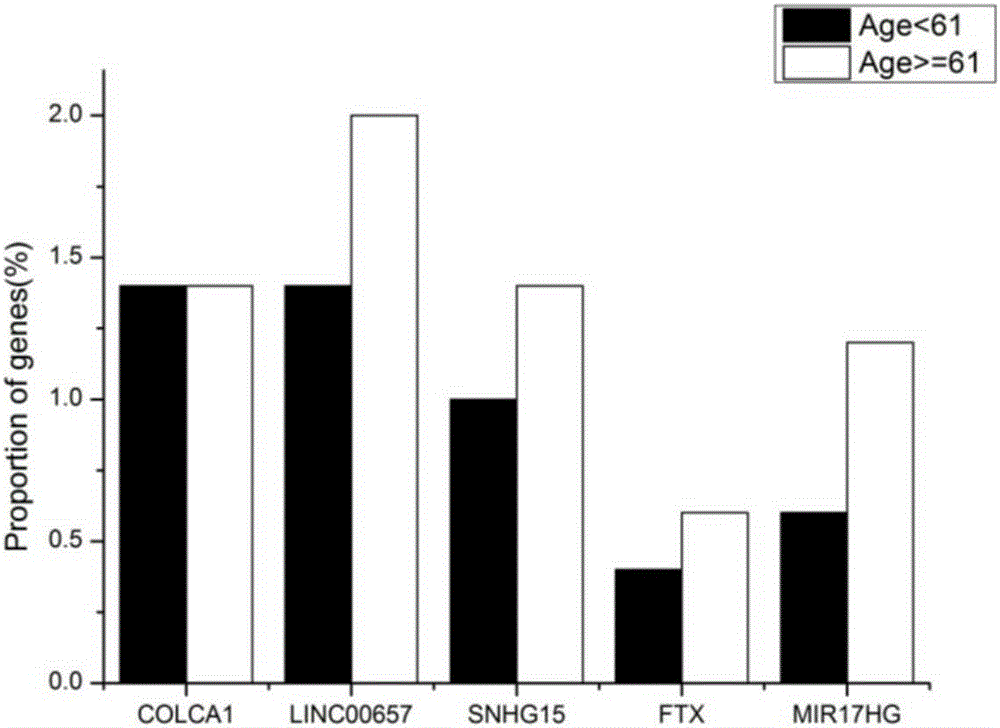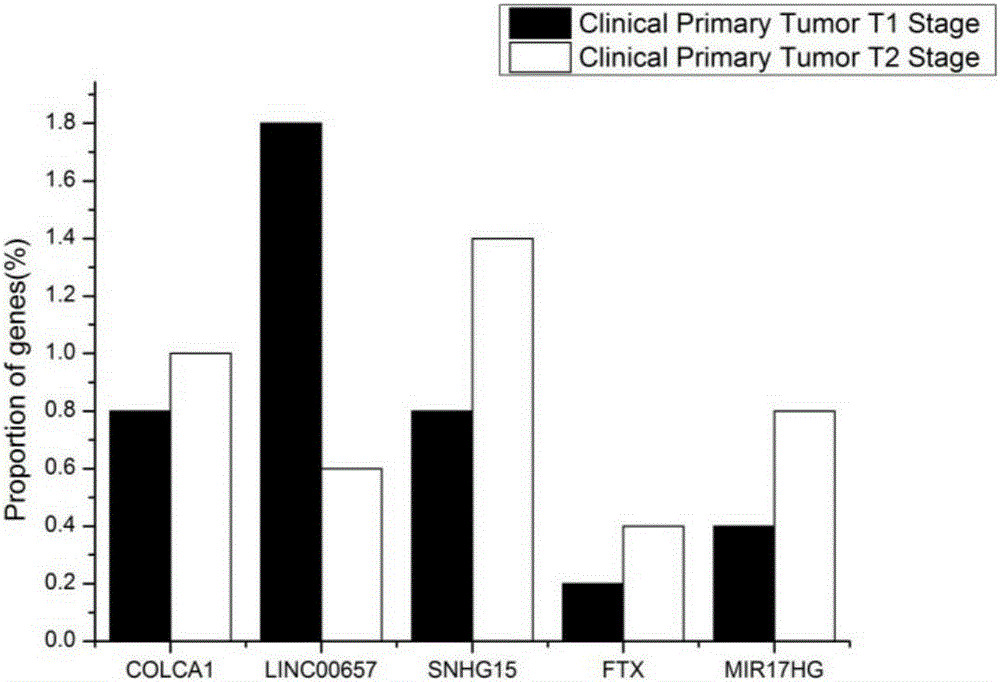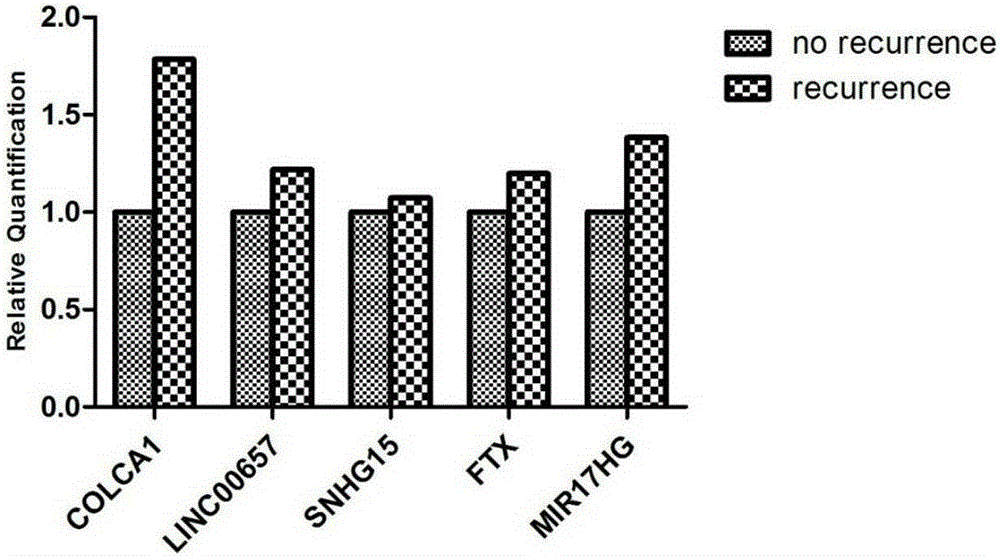LncRNA and application thereof as prostatic cancer detection marker or prostatic cancer prognosis recurrence marker
A prostate cancer and prognosis technology, applied in the field of biomedicine, can solve problems such as the difference in the incidence rate of pathological detection of prostate cancer
- Summary
- Abstract
- Description
- Claims
- Application Information
AI Technical Summary
Problems solved by technology
Method used
Image
Examples
Embodiment 1
[0073] The relationship between the quantitative analysis of the expression of the embodiment 1LncRNA in the prostate cancer tissue and the age of the disease
[0074] In the database website http: / / www.cbioportal.org / , the pathological information of prostate cancer tissue and prostate cancer adjacent tissue samples according to "Mutations Putative copy-number alterations from GISTIC mRNAExpressionz-Scores (RNASeqV2RSEM)" was screened to obtain the complete pathological information of 499 prostate cancer samples, as shown in Table 1 below:
[0075] Table 1 Clinicopathological information of patients with prostate cancer and adjacent tissues
[0076]
[0077] According to the disease age in the pathological information of 499 prostate cancer samples, the prostate cancer samples were divided into three age groups (figure 1 .
[0078] From figure 1 It can be seen that the expression ratio of LINC00657, SNHG15, FTX, MIR17HG in the high age group is higher than that in the...
Embodiment 2
[0079] Example 2 LncRNA Expression in Prostate Cancer Tissue Sequencing Results Analysis on Pathological Grading
[0080] According to the TCGA tumor database, the 499 samples of prostate cancer samples screened in Example 1 that have been subjected to RNA sequencing were analyzed, and the analysis was carried out according to 2,530 LncRNAs approved in http: / / www.genenames.org / . LncRNA expression in prostate cancer samples with tumor size T1 (86 cases) and T2 (67 cases), the results of the investigation can be found in figure 2 .
[0081] Depend on figure 2 It can be seen that the expression ratio of COLCA1, SNHG15, FTX, and MIR17HG in the T1 stage of prostate cancer was 20%, 60%, 20% and 40% lower than that in the T2 stage, while the expression ratio of LINC00657 in the T1 stage of prostate cancer was lower than that in the T2 stage. period was significantly higher by 1.2 times.
[0082] These five LncRNA molecules, especially COLCA1, SNHG15, FTX, and MIR17HG, can be use...
Embodiment 3
[0083] Example 3 LncRNA expression level differences between recurrent and non-recurrent prostate cancer tissues
[0084]Analyzing the prognosis of prostate cancer samples in Table 1, it was found that there were 9 cases with prognosis recurrence, namely: TCGA-EJ-5524, TCGA-EJ-5525, TCGA-EJ-5526, TCGA-CH-5791, TCGA-M7- A724, TCGA-J4-A67N, TCGA-CH-5751, TCGA-G9-6332, TCGA-CH-5743, and the remaining 490 cases had no recurrence.
[0085] According to the high-throughput sequencing results of 499 prostate samples, the expression levels of target LncRNAs in relapsed and non-relapsed cases were analyzed, and it was found that COLCA1 (RQ=1.785), LINC00657 (RQ=1.218), SNHG15 (RQ=1.072), FTX (RQ=1.198) and MIR17HG (RQ=1.382) are significantly highly expressed in prostate cancer recurrence cases, so the expression of these five LncRNAs in prostate cancer tissue can significantly predict the prognosis of recurrence patients, and can better guide prostate cancer Clinical treatment of can...
PUM
 Login to View More
Login to View More Abstract
Description
Claims
Application Information
 Login to View More
Login to View More - R&D Engineer
- R&D Manager
- IP Professional
- Industry Leading Data Capabilities
- Powerful AI technology
- Patent DNA Extraction
Browse by: Latest US Patents, China's latest patents, Technical Efficacy Thesaurus, Application Domain, Technology Topic, Popular Technical Reports.
© 2024 PatSnap. All rights reserved.Legal|Privacy policy|Modern Slavery Act Transparency Statement|Sitemap|About US| Contact US: help@patsnap.com










